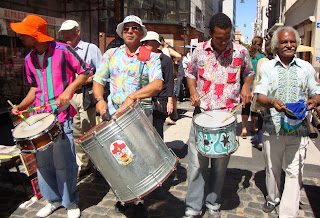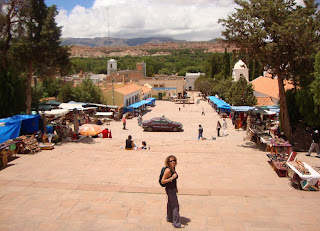Monday, 28 February 2011
Tango in the Park
If a woman were seen stroking her foot up a man's leg almost to his crotch and then being dragged along with only the tips of her stiletto shoes touching the ground as she clings on to his shoulders staring passionately into his eyes wearing a slinky skirt split up to her hip, they would probably be carted off by the police. But here it's an everyday sight as you sit and enjoy a cold beer in the sunshine.
Recoleta Park
 From San Telmo, we took the bus to Recoleta, the barrio with a distinct Parisian feel. Buenos Aires is simply a fandango fabuloso (party central) every Sunday. The parks are full of picnic-ers, live bands, jugglers, tumblers, people blowing bubbles, dancing, merrymaking and performers in outrageous costumes. FUN meter in the red (with no yobs, drunks or chavs!)
From San Telmo, we took the bus to Recoleta, the barrio with a distinct Parisian feel. Buenos Aires is simply a fandango fabuloso (party central) every Sunday. The parks are full of picnic-ers, live bands, jugglers, tumblers, people blowing bubbles, dancing, merrymaking and performers in outrageous costumes. FUN meter in the red (with no yobs, drunks or chavs!)
San Telmo Market

 Back in Buenos Aires, it's Sunday, the day that the barrio of San Telmo comes alive with an antiques and bric-a-brac market along a half-mile street of endless fun and fancy goods. There's beautiful hand-crafted jewellery and great leather. No pushing or shoving, just lots of live
Back in Buenos Aires, it's Sunday, the day that the barrio of San Telmo comes alive with an antiques and bric-a-brac market along a half-mile street of endless fun and fancy goods. There's beautiful hand-crafted jewellery and great leather. No pushing or shoving, just lots of live music and old men, eyes closed, playing seductive tango tunes on battered accordians. Wonderful vibe!
Arrechea Waterfall, Iguazu
Macuco Trail
Wildlife
 There's rich wildlife here, more than 430 species of birds (saw toucans with huge orange cartoon beaks), 70 species of mammals (eg pumas, tapirs, capuchin and howler monkeys) and friendly coati with their spriped tails. We took a long walk through the jungle and saw electric blue butterflies the size of our hand and an alarmingly large lizard. The spiders were big, too, and as we walked along we sometimes collided with their webs and had to fight to get them off. If someone had seen us from a distance they'd have thought we were having some strange fit! One monster spider (with segmented limbs ie forearm, upper arm and deltoid) was devouring a poor flapping butterfly. Younger sis wanted to catapult a stone at it like Denis the Menace and break the web but older sis squeezed her arm restrainingly and said, "the spiders have a right to be here, too, and they're an important part of the ecosystem"....and we moved gently on.
There's rich wildlife here, more than 430 species of birds (saw toucans with huge orange cartoon beaks), 70 species of mammals (eg pumas, tapirs, capuchin and howler monkeys) and friendly coati with their spriped tails. We took a long walk through the jungle and saw electric blue butterflies the size of our hand and an alarmingly large lizard. The spiders were big, too, and as we walked along we sometimes collided with their webs and had to fight to get them off. If someone had seen us from a distance they'd have thought we were having some strange fit! One monster spider (with segmented limbs ie forearm, upper arm and deltoid) was devouring a poor flapping butterfly. Younger sis wanted to catapult a stone at it like Denis the Menace and break the web but older sis squeezed her arm restrainingly and said, "the spiders have a right to be here, too, and they're an important part of the ecosystem"....and we moved gently on.

Garganta del Diablo (Devil's Throat)
Circuito Inferior
Iguazu Falls
 If ever there were an interplanetary beauty contest (a sort of Miss Universe for Locations), Earth's entry would be Iguazu. Nowhere encapsulates the magic and abundance of this world in such style: huge irridescent butterflies, billions of gallons of tumbling water, thunder, cool mist enshrouding vivid colours of ancient rocks and forest. Gigantic dragon flies hover in the spray, huge condors soar overhead, bright toucans fly acoss billowing white cumulus in a blue blue sky, the whole scene encircled by shiny bright rainbows. Our lives are without doubt richer for having seen this magnificent place.
If ever there were an interplanetary beauty contest (a sort of Miss Universe for Locations), Earth's entry would be Iguazu. Nowhere encapsulates the magic and abundance of this world in such style: huge irridescent butterflies, billions of gallons of tumbling water, thunder, cool mist enshrouding vivid colours of ancient rocks and forest. Gigantic dragon flies hover in the spray, huge condors soar overhead, bright toucans fly acoss billowing white cumulus in a blue blue sky, the whole scene encircled by shiny bright rainbows. Our lives are without doubt richer for having seen this magnificent place.
Arriving at Iguazu Falls

With no washbag or clean clothes, Anita's body odour was face-crumpling, her one outfit minging in the heat and humidity. So the Guide, unable to carry on without nose pegs, marched us into a shop and we bought these 2 polyester dresses for a tenner which we wore the whole time - even went swimming in them at the Falls - they turned out to be just the ticket because they dried in seconds. Fortunately our luggage was at Iguazu airport when we checked in to leave two days later.
Hito Tres Fronteras (3 Borders Landmark)
 You can see 3 countries and the Iguazu River from this point. Young kids were hawking orchid plants and little rolls of the local chipita bread made from mandioc root (very tasty).
You can see 3 countries and the Iguazu River from this point. Young kids were hawking orchid plants and little rolls of the local chipita bread made from mandioc root (very tasty).
We're standing in Argentina with impressive views over the rivers and neighbouring Brazil on the right and Paraguay on the left.
From Salta to Iguazu
 To save time, we opted to fly from Salta to Iguazu rather than take the bus which would've taken 24 hours. DISASTER! The airline lost our bags so for two days at Iguazu Falls we had only our backpacks. Our travel clothes were filthy and far too warm for the swelteringly hot subtropical climate. While waiting for our bags to arrive, we took a stroll up an attracitve costanera (coastal path) along the Rio Iguazu, past a small port where boats were leaving for cruises to Paraguay and on up to a spectacular viewpoint high above the meeting of the two rivers, Parana and Iguazu, known as the Hito Tres Fronteras (3 borders landmark). The tropical flowers are lovely - they really are almost as good as the silk ones in John Lewis!
To save time, we opted to fly from Salta to Iguazu rather than take the bus which would've taken 24 hours. DISASTER! The airline lost our bags so for two days at Iguazu Falls we had only our backpacks. Our travel clothes were filthy and far too warm for the swelteringly hot subtropical climate. While waiting for our bags to arrive, we took a stroll up an attracitve costanera (coastal path) along the Rio Iguazu, past a small port where boats were leaving for cruises to Paraguay and on up to a spectacular viewpoint high above the meeting of the two rivers, Parana and Iguazu, known as the Hito Tres Fronteras (3 borders landmark). The tropical flowers are lovely - they really are almost as good as the silk ones in John Lewis!
Mama Paca Restaurant
 Thanks to the 'Footprint' guidebook, we found this charming and cheap Spanish eatery serving mouthwatering fresh fish. The waiter, more bull than matador, was a jolly Spanish telly-tubby who kept the wine coming - a delicious, crisp Torrontes (white) from Cafayate for 5 quid a bottle.
Thanks to the 'Footprint' guidebook, we found this charming and cheap Spanish eatery serving mouthwatering fresh fish. The waiter, more bull than matador, was a jolly Spanish telly-tubby who kept the wine coming - a delicious, crisp Torrontes (white) from Cafayate for 5 quid a bottle.
Argentinian Tradition

Two very typical expressions of Salta - folkloric costumes and allegedly the best empenadas in Argentina - we had no argument with that - the selection of beer, chicken and cheese tasted even better with the local beer.

Wednesday, 23 February 2011
Salta's Main Plaza and Cathedral
 Now in the northwest of Argentina in Salta, one of the country's most charismatic and historical cities. It's the least "Europeanised" and home to most of the country's indigenous people. This is the Cathedral in the central plaza painted in a very attractive pastel pink and beautifully illuminated at night.
Now in the northwest of Argentina in Salta, one of the country's most charismatic and historical cities. It's the least "Europeanised" and home to most of the country's indigenous people. This is the Cathedral in the central plaza painted in a very attractive pastel pink and beautifully illuminated at night.
Wild Waters - Fancy a Dip?
Argentina's Monument Valley
Rock Formations
Cafayate Gorge
 This landscape is a delicious feast of colour : chocolate-coloured mountains, raspberry-ripple strata, pistachio and treacle peaks and rhubarb and cream, all on a burnt treacle platter.
This landscape is a delicious feast of colour : chocolate-coloured mountains, raspberry-ripple strata, pistachio and treacle peaks and rhubarb and cream, all on a burnt treacle platter.
We think this sign means, "If you look without seeing, the ground will seem no more than just the ground." (Our interpretation : look beyond...see the beauty and intelligence in Nature)
Quebrada de las Conchas (Gorge of Shells)
Maimara
 Maimara is a tranquil oasis village with green fields of onion and garlic set in contrast with this backdrop of richly coloured marbled rock known as 'La Paleta del Pintor'. The colours in the strata are formed by many different minerals
Maimara is a tranquil oasis village with green fields of onion and garlic set in contrast with this backdrop of richly coloured marbled rock known as 'La Paleta del Pintor'. The colours in the strata are formed by many different minerals 
including iron, sulphur, quartz, copper, clay and even bodies of old crustacea (it used to be under water). There's a huge cemetery on the hillside, always brightly decorated at Easter.
Tilcara
 Tilcara is the site of an important pre-Hispanic settlement and this is the restored hilltop fortress with magnificent panoramic views of the gorge. These pictures don't capture the spirit of the place which was truly palpable - we knew we were on a site of extraordinary beauty and ancient wisdom. In their humble adobe dwellings, they made food, jewellery, pots and ate the local hallucinogenic plants - can you imagine what a bad day it must've been when they saw the Spanish army approaching, brandishing crosses and swords?!
Tilcara is the site of an important pre-Hispanic settlement and this is the restored hilltop fortress with magnificent panoramic views of the gorge. These pictures don't capture the spirit of the place which was truly palpable - we knew we were on a site of extraordinary beauty and ancient wisdom. In their humble adobe dwellings, they made food, jewellery, pots and ate the local hallucinogenic plants - can you imagine what a bad day it must've been when they saw the Spanish army approaching, brandishing crosses and swords?!
Tilcara
Menu in Humahuaca
Humahuaca
Subscribe to:
Comments (Atom)


























